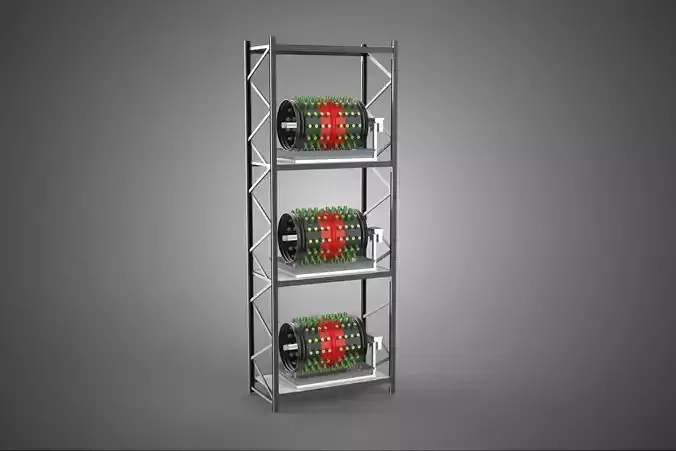1/42
High-quality 3D assets at affordable prices — trusted by designers, engineers, and creators worldwide. Made with care to be versatile, accessible, and ready for your pipeline.
Included File Formats
This model is provided in 14 widely supported formats, ensuring maximum compatibility:
• - FBX (.fbx) – Standard format for most 3D software and pipelines
• - OBJ + MTL (.obj, .mtl) – Wavefront format, widely used and compatible
• - STL (.stl) – Exported mesh geometry; may be suitable for 3D printing with adjustments
• - STEP (.step, .stp) – CAD format using NURBS surfaces
• - IGES (.iges, .igs) – Common format for CAD/CAM and engineering workflows (NURBS)
• - SAT (.sat) – ACIS solid model format (NURBS)
• - DAE (.dae) – Collada format for 3D applications and animations
• - glTF (.glb) – Modern, lightweight format for web, AR, and real-time engines
• - 3DS (.3ds) – Legacy format with broad software support
• - 3ds Max (.max) – Provided for 3ds Max users
• - Blender (.blend) – Provided for Blender users
• - SketchUp (.skp) – Compatible with all SketchUp versions
• - AutoCAD (.dwg) – Suitable for technical and architectural workflows
• - Rhino (.3dm) – Provided for Rhino users
Model Info
• - All files are checked and tested for integrity and correct content
• - Geometry uses real-world scale; model resolution varies depending on the product (high or low poly)
• • - Scene setup and mesh structure may vary depending on model complexity
• - Rendered using Luxion KeyShot
• - Affordable price with professional detailing
Buy with confidence. Quality and compatibility guaranteed.
If you have any questions about the file formats, feel free to send us a message — we're happy to assist you!
Sincerely,
SURF3D
Trusted source for professional and affordable 3D models.
More Information About 3D Model :
A Stacked Vertical Garden Tower Frame Rotary Hydroponic Plant Farm represents an advanced, high-density indoor agricultural system that integrates multiple innovative cultivation technologies to maximize plant production within a confined space. This sophisticated facility combines vertical farming principles, a unique rotary mechanism, and hydroponic nutrient delivery to create an optimized, controlled environment for crop growth.
At its core, the system is structured around a Stacked Vertical Garden Tower Frame. This framework is engineered to support multiple tiers or layers of plants arranged vertically. Unlike traditional horizontal farming, this vertical orientation dramatically increases the cultivable area per unit of land footprint, making it particularly suitable for urban environments or regions with limited arable land. The tower frame aspect implies a robust structural design capable of supporting the weight of numerous plants, growing media, nutrient solutions, and associated equipment across various elevations.
The most distinctive feature of this system is its Rotary mechanism. Plants are mounted on trays, panels, or individual holders that are affixed to a central axis or a series of interconnected frames designed to rotate. This rotation serves several critical functions:
- Uniform Light Exposure: By continuously moving plants through a cycle, each plant receives consistent and optimized exposure to a fixed light source, often a high-efficiency LED array, minimizing shadowing and ensuring even growth across the entire cultivation area. This can also allow for the use of fewer, more powerful central light sources, improving energy efficiency compared to individually lit vertical layers.
- Even Nutrient Distribution: As plants rotate, they may pass through or receive drips of nutrient solution, ensuring all plants access an equitable supply of water and dissolved minerals.
- Space Maximization: The rotational design, sometimes referred to as a ferris wheel or carousel system, can further increase planting density by presenting plants in a compact, dynamic array that continuously cycles through optimal growth conditions.
The cultivation method employed is Hydroponic, a soilless agricultural technique where plants are grown in nutrient-rich water solutions instead of soil. This approach offers several advantages:
- Water Efficiency: Hydroponic systems, especially closed-loop designs, recirculate nutrient solutions, significantly reducing water consumption compared to traditional soil-based agriculture, often by as much as 70-90%.
- Optimized Nutrient Delivery: Plant roots are directly exposed to precisely balanced nutrient solutions, leading to faster growth rates and potentially higher yields.
- Reduced Pest and Disease Pressure: The absence of soil and the controlled indoor environment inherently reduce the incidence of soil-borne pests and diseases, minimizing the need for pesticides.
- Environmental Control: The entire Plant Farm operates within a controlled environment, where factors such as temperature, humidity, CO2 levels, and light spectrum can be precisely regulated to create ideal growing conditions for specific crops, enabling year-round production irrespective of external climatic conditions.
In operation, plants are typically housed in inert growing media (e.g., rockwool, coco coir, clay pebbles) supported by the rotating frames. A central pump system delivers the customized hydroponic nutrient solution from a reservoir to the plants, either through drip irrigation, nutrient film technique (NFT), or aeroponics, often timed to coincide with the plants' rotational cycle. Environmental sensors continuously monitor critical parameters, with data often fed into an automated control system that adjusts lighting, climate, and nutrient delivery as needed.
The Stacked Vertical Garden Tower Frame Rotary Hydroponic Plant Farm represents a cutting-edge solution for sustainable agriculture, particularly valuable for urban farming, research, and high-value crop production. Its integration of vertical space utilization, dynamic plant positioning, and soilless cultivation aims to achieve unprecedented levels of productivity and resource efficiency in modern food systems.
KEYWORDS: Vertical farming, hydroponics, rotary system, controlled environment agriculture, urban agriculture, indoor farming, plant factory, soilless cultivation, aeroponics, nutrient film technique, stacked cultivation, high-density farming, sustainable agriculture, resource efficiency, automated farming, LED grow lights, plant growth optimization, food security, innovative agriculture, climate control, water conservation, commercial farming, crop production, modular design, agricultural technology, smart farming, precision agriculture, yield maximization, closed-loop system, automated nutrient delivery.
REVIEWS & COMMENTS
accuracy, and usability.










































